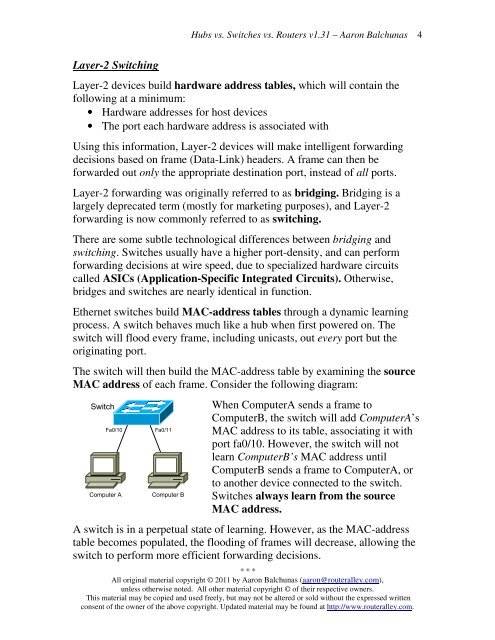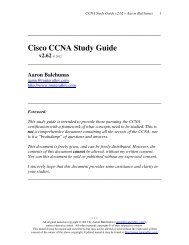Hubs vs. Switches vs. Routers - Router Alley
Hubs vs. Switches vs. Routers - Router Alley
Hubs vs. Switches vs. Routers - Router Alley
You also want an ePaper? Increase the reach of your titles
YUMPU automatically turns print PDFs into web optimized ePapers that Google loves.
Layer-2 Switching<br />
<strong>Hubs</strong> <strong>vs</strong>. <strong>Switches</strong> <strong>vs</strong>. <strong><strong>Router</strong>s</strong> v1.31 – Aaron Balchunas<br />
Layer-2 devices build hardware address tables, which will contain the<br />
following at a minimum:<br />
• Hardware addresses for host devices<br />
• The port each hardware address is associated with<br />
Using this information, Layer-2 devices will make intelligent forwarding<br />
decisions based on frame (Data-Link) headers. A frame can then be<br />
forwarded out only the appropriate destination port, instead of all ports.<br />
Layer-2 forwarding was originally referred to as bridging. Bridging is a<br />
largely deprecated term (mostly for marketing purposes), and Layer-2<br />
forwarding is now commonly referred to as switching.<br />
There are some subtle technological differences between bridging and<br />
switching. <strong>Switches</strong> usually have a higher port-density, and can perform<br />
forwarding decisions at wire speed, due to specialized hardware circuits<br />
called ASICs (Application-Specific Integrated Circuits). Otherwise,<br />
bridges and switches are nearly identical in function.<br />
Ethernet switches build MAC-address tables through a dynamic learning<br />
process. A switch behaves much like a hub when first powered on. The<br />
switch will flood every frame, including unicasts, out every port but the<br />
originating port.<br />
The switch will then build the MAC-address table by examining the source<br />
MAC address of each frame. Consider the following diagram:<br />
Switch<br />
Computer A<br />
Fa0/10 Fa0/11<br />
Computer B<br />
When ComputerA sends a frame to<br />
ComputerB, the switch will add ComputerA’s<br />
MAC address to its table, associating it with<br />
port fa0/10. However, the switch will not<br />
learn ComputerB’s MAC address until<br />
ComputerB sends a frame to ComputerA, or<br />
to another device connected to the switch.<br />
<strong>Switches</strong> always learn from the source<br />
MAC address.<br />
A switch is in a perpetual state of learning. However, as the MAC-address<br />
table becomes populated, the flooding of frames will decrease, allowing the<br />
switch to perform more efficient forwarding decisions.<br />
* * *<br />
All original material copyright © 2011 by Aaron Balchunas (aaron@routeralley.com),<br />
unless otherwise noted. All other material copyright © of their respective owners.<br />
This material may be copied and used freely, but may not be altered or sold without the expressed written<br />
consent of the owner of the above copyright. Updated material may be found at http://www.routeralley.com.<br />
4

















